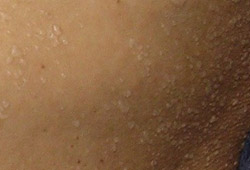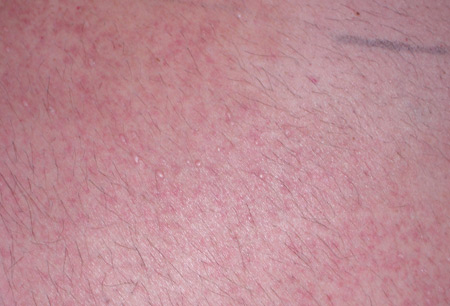History and exam
Key diagnostic factors
common
nonfollicular vesicles and papules (all types)
Nonspecific sign. However, all forms of miliaria are associated with nonfollicular lesions as the disease involves the eccrine duct and not the hair follicle.[1]
asymptomatic eruption (crystallina)
The vesicular eruption of miliaria crystallina is asymptomatic.[1]
clear noninflammatory vesicles (crystallina)
Miliaria crystallina is associated with clear noninflammatory vesicles.[1][Figure caption and citation for the preceding image starts]: Miliaria crystallina in hospitalized febrile patientFrom Brian L. Swick's collection, used with permission [Citation ends].
fragile vesicles (crystallina)
Miliaria crystallina is associated with fragile vesicles that often rupture with only slight friction and release a clear fluid.[1]
paroxysmal pruritus and stinging (rubra)
erythematous papulovesicles (rubra)
Nonspecific sign. However, miliaria rubra is associated with erythema unlike miliaria crystallina and miliaria profunda.[1][Figure caption and citation for the preceding image starts]: Miliaria rubraFrom Brian L. Swick's collection, used with permission [Citation ends].
anhidrosis (profunda)
A key symptom in miliaria profunda is profound anhidrosis in the areas of involvement.[1] This can be severe enough to induce heat exhaustion, also referred to as tropical anhidrotic asthenia.[1][27] Miliaria rubra can also be associated with episodic anhidrosis in affected sites.[1][2] However, these episodes tend to be less severe than those associated with miliaria profunda.[1]
compensatory hyperhidrosis (profunda)
Miliaria profunda is often associated with compensatory hyperhidrosis of the face, axillae, hands, and feet.[1]
flesh-colored papules (profunda)
Nonspecific sign. However, miliaria profunda is associated with deep-seated papules.[1]
Other diagnostic factors
common
desquamative healing (crystallina)
Miliaria crystallina resolves with "branny" desquamation.[1]
uncommon
weakness and malaise (profunda)
Heat exhaustion (tropical anhidrotic asthenia) in miliaria profunda is associated with weakness and malaise.
dyspnea (profunda)
Heat exhaustion (tropical anhidrotic asthenia) in miliaria profunda is associated with dyspnea.[1]
tachycardia (profunda)
Heat exhaustion (tropical anhidrotic asthenia) in miliaria profunda is associated with tachycardia.[1]
hyperpyrexia (profunda)
Heat exhaustion (tropical anhidrotic asthenia) in miliaria profunda is associated with hyperpyrexia.[1]
Risk factors
strong
profuse sweating
The primary pathogenic factor in all forms of miliaria is excessive sweating leading to overhydration of the stratum corneum, in turn leading to acrosyringeal duct disruption.[16] In addition, excessive sweating increases the concentration of sodium chloride in the epidermis further leading to maceration of the stratum corneum and acrosyringeal duct disruption.[16]
Skin macerated by excessive sweating contains higher numbers of Staphylococcus epidermidis, which may contribute to the formation of miliaria through the production of a polysaccharide substance that may obstruct the acrosyringeal duct.[18][19]
Ubiquitous association with miliaria.
excessive heat and humidity
Profuse sweating induced by excessive heat and humidity leads to miliaria.
Ubiquitous association with miliaria.
occlusive clothing
febrile illness
Profuse sweating induced by a febrile illness leads to miliaria.
Common association especially in hospitalized patients.
repeat episodes of miliaria rubra (for miliaria profunda)
ultraviolet light exposure
Sunburn plays a role in a subset of miliaria crystallina by inducing acrosyringeal duct disruption at the level of the stratum corneum.
Ultraviolet radiation epidermal cells are extruded and sandwiched between old and new corneocytes in the stratum corneum. These cells allow for dehiscence of the intra-corneal acrosyringeal duct and, if heavy sweating occurs, allows for the accumulation of sweat forming miliaria.[16]
weak
neonatal age
Miliaria crystallina is seen in 4.5% of infants while miliaria rubra is seen in between 4% and 9% of infants.[5][11]
Mechanisms to explain the occurrence of miliaria crystallina in newborns include: a) the presence of immature sweat ducts during the first 2 weeks of life; b) maternal fever in select cases; c) moist occlusive environment created by amniotic fluid and vernix.[3][6]
cholinergic medications
Eccrine glands are innervated by sympathetic fibers which release acetylcholine in order to cause sweating. Therefore, cholinergic medications cause increased sweating and in some cases have been associated with the production of miliaria. Bethanechol, a cholinergic medication that can induce sweating, has been associated with miliaria crystallina.[22]
isotretinoin
Alterations in the stratum corneum can result in acrosyringeal duct disruption and miliaria formation. Isotretinoin, a vitamin A derivative that alters the differentiation of keratinocytes, has been associated with the formation of miliaria crystallina.[23]
doxorubicin
staphylococcal scalded skin syndrome
atopic dermatitis
Miliaria rubra has been reported in patients with underlying atopic dermatitis. However, this association is weak as the individuals described in the case report were concurrently exposed to tropical heat and humid conditions while working in a mine in Australia.[26]
Use of this content is subject to our disclaimer